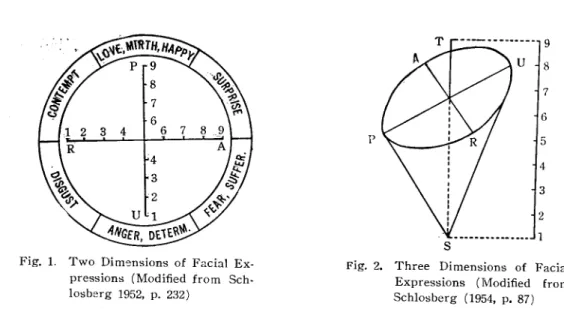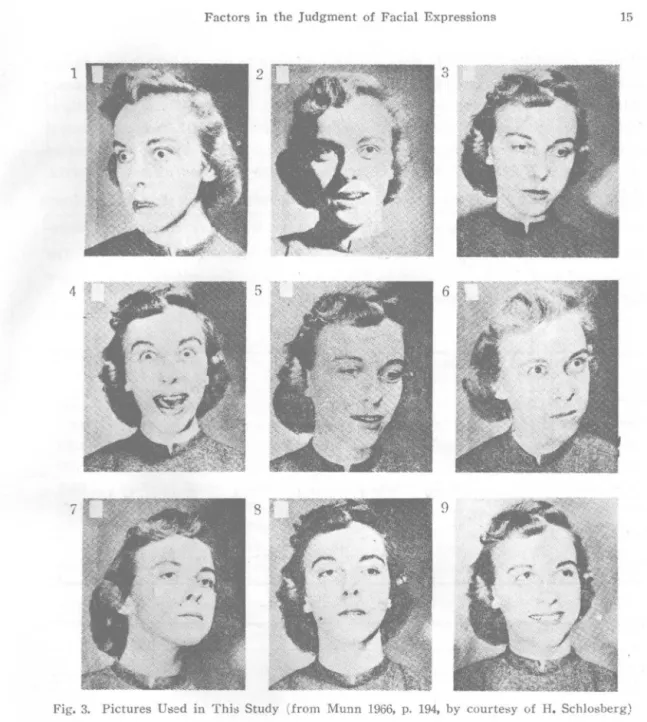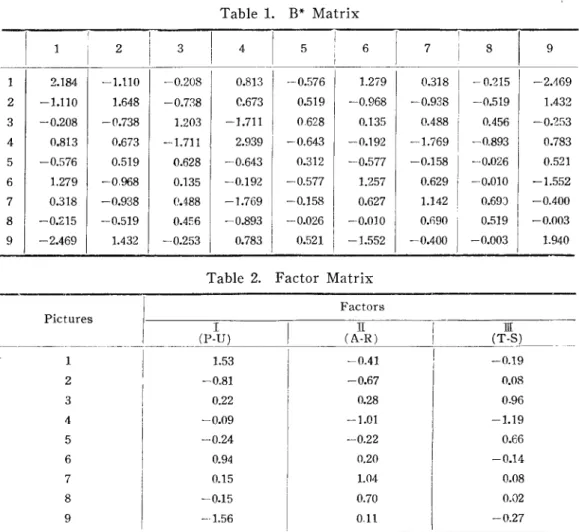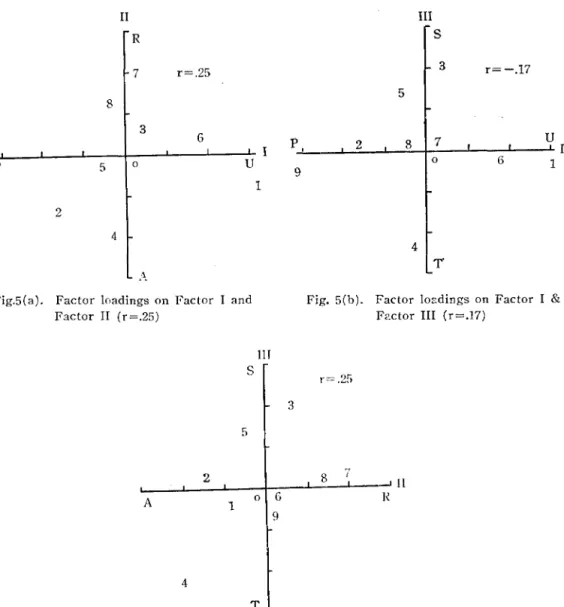13
FACTORS IN THE JUDGMENT OF F ACIAL EXPRESSIONS
CHEN-SHAN LINA set of 9 pictures posed to represent di任ernt facial expressions were used as stimuls objects and were presented to a group of 25 male graduate students by using the complete method of triads. Data thus obtained were analysed under Torgerson's multidimensional scaling technique. Three factors were extracted from B* matrix and were identified as Pleasantness-Unpleasantness, Attention-Rejection,
and Tension-Sleep. The Three Dimensions Theory hypothesized by Schlosberg was shown to be quite sound. A way for further study by using the method suggested in this study was also emphasized.
In a study of Woodworth's scale of facial expression, Schlosbers (1941) asked each of his 45 subjects to sort three sets of 72 Fois-Wittmann pictures (Froit-Wittmar凹, 1930; Hullin and Katz, 1935) into the following 6 ordered categories: (1) Love, Happiness, Mirth; (2ì Surprise; (3) Fear, Suffering; (4) Anger, Determination; (5) Disgust; (6) ContemPt. Finding out the fact that, in some cases, pictures posed to express Category (1) were confused with those posed to express Category (6), he thought Woodworth's scale was not a uniiime的ional scale but rather a circular one with Category (1) and Category (6) near together. This meant that there were two factors involved in the judgment of facial expressions. And therefore he said
,
“It is possible that some other technique
,
such as a form of factor analysis,
may eventually be of value in determing the axes, and the factors basic to the scale." (p. 507). Later, Schlosberg (1952) forced his subjects to sort a set of same pictures along a 9-point rating scale ranging from most unpleasant (1) to most pleasant (9) and then to sort on a scale from Rejection (1) to Attention (9). Facial expressions were judged in terms of two dime的ions, that is, Pleasantness咽 Unpleasantness and Attention-Rejection. As a resu1t, each picture was plotted on a roughly circular surface as shown in Fig. 1. A1though he had predicted the use of factor analysis,
he did not use this technique in his study. Two years later (1954), in the article named“
Three Dimensions of Emotion", he suggested a third factor, Tension.Sleep, for the judgment of facial expressions. Fig. 2 shows his ideas. However, he did not undertake any experiment to prove his theory. Three dime的ions theory remains to be a hypothesis only.From what we have reviewed above, we know that Schlosberg assumed before his experiment that he had already known what factors were involved in the judg-ment of facial expressions, and then urged his subjects to sort pictures in terms of these unproved factors. His method was mainly deductive. The purposes of the present study are (1) to find out factors involved in the judgment of facial expres-sions in order to test the Three dimenexpres-sions theory, and (2) to locate the scale posi-tions for a set of 9 pictures by using Torgerβon's Multidimensional Scaling technique.
14 心理與歡育 U
-Js
7 6 P 5 4 3 2Fig. 1. Two Dimensions of Facia! Ex-pressions (Modified from Sch-losberg 1952, p. 232)
Fig. 2. Three Dimensions of Facia! Expressions (Modified from Schlosberg (1954, p. 87)
The method used in this study is inductive rather than deductivc. Factors involved are assumed to be unknown before cxpεriment and are to be found out by the author.
METHOD
A set of 9 pictures posed by a same Caucasian woman were uesd as stimulus objects. (Fig. 3). These pictures were iIIustrated by N. L. Munn in his Psychology
(1966, p. 194), by courtesy of H. Schlosberg. Each of these pictures was attached to a 8 cm. X 10 cm. cardboard and was randomly numbered on the back. Twenty-five male graduate students from China, Japan, and Thailand served as subjects. (Cau-casian, in the viewpoint of Oriental; W oman, in the viewpoint of men!) They were instructed to judge the pictures in terms of emotional expressions and by first impression. The pictures were presented to each subject by using the complete method of triads. One picture among each triads served as
‘
Target'. The subject must judge which one of the other two pictures was more similar to the target.His judgment
,
or choice,
for every triads was recorded in the answer sheets by the experimenter. AII 252 possible triads (= 3x CV were presented to each subject in a random order as suggested by Ross (1934). At last, judgments by aII 25 subjects were obtained. They were tabulated together to form 9 frequency matrices. The 9 frequency matrices were then turned into a scalar product matrix,
B著 Matrix, by foIIowing Torgerson's Mu!tidimensiona! Scaling technique. (Torgerson, 1958). This B普 matrix was uesed as basic data for factor analysis as weII as Guttman-Lingoes' SmaII Space Analysis,
SSA. (Lingoes,
1965). This was the first part of this study,
and was foIIowed by the second. After each subject had judged the whole 252 triads, he was asked to arrange the 9 pictures in terms of Pleasantness-Unpleansatness. At last,
by the use of Simρlified Ranko
1'de r,
a Iinear scale was obtained,
and its ~calab iI ity tested.Factors in the Judgment of Facia! Expressions 15
1 2 3
6
7 S
。
Fig. 3. Pictures U8ed in Thi8 Study (from Munn 1966, p. 194, by courtesy of H. Schl08berg)
RESULTS
Fig. 4 shows the linear scale obtained. The order obtained was respectively Pictures 1, 6, 7, 3, 8, 5, 4, 2, and 9. Apparently the order was not 1, 6, 3, 7, 8, 5, 2,
9, and 4, as given by Munn (1966) in his textbook (p. 603). This meant that some Pictures O U 1 回 .1 6
.e
' .2 73 8 簣If*
.
'
.3 .4 .5 5 4 2 9 H* *
回'
'
'
' .6 .7 .8 .9 1.0 PFig. 4. A 8cale for nine picture8 from m08t unpleasaIlt to m08t plea8ant by u8ing the 8implified rank ol"(\l)r method,
nn 1
心理與教育
pictures
,
especiaIIy Picturc 4,
were rather confusing to our subjects in one dimen-sional judgment. It was clear that our subjects had not judged in one dimension only. Factor analysis was therefore necessary_ Then, from B著 Matrix , Table 1, three factors were extracted by the help of computor program, BMDX72, using principal component solution and oblique rotation. The factor loadings of these three factors are shown in Table 2_ The sum of squares of the elements of the B骨 Matrix ,.. ..、,
2:2: b*2, was 81.4, whi1e the sum of squares of elements in B著 Matrixderived from j k jk
.. n
the three factors, 2:2: b2, was 78.5. These two sums were very nearly equal, there-j k jk
fore the process of factoring was stopped. (See Torgerson, 1958, p. 297). The loadings of each factor are plotted in Fig. 5(a) to 5(c). Thc intercorrelations show the degree of obliqueness between relevant factors.
Table 1. B著 Matrix 2 3 4 5 6 7 8 9 1 2.184 2 一1.1 10 1.648 I -0.7:l8 C.673 I 0.519 I -0.968 • 0.938 I -0.519 I 1.432 3 一 0.208 -0.738 1.203 一1.711 0628 I 0.135 0.488 I 0.456 一 0.253 4 0.813 0.673 一1. 711 2.939 • 0.643 I -0.192 I -1.769 -0.893 I 0.783 5 -0.576 0.519 。.628 • 0.643 i 0.312 一 0.5 77 I -0.158 I -0.026 I 0.521 6 1.279 • 0.968 0.135 一 0.192 I -0.577 I 1.257 I 0.629 i -0.010 I -1.552 7 0.318 -0.938 。.488 一 1.769 I -0.158 I 0.627 I 1.142 0.69J -0.400 8 一 0.215 -0.519 0.4E6 9 一 2.469 1.432 一 0.253 0.783 I 0.521 I -1.552 • 0.400 I -0.003 I 1.940
Table 2. Factor Matrix
Pictures Factors
By BMDX72 computor program, using princip31 CDmpon~nt solution & obliq口e rotation.
IN--ω
2 • 0.81 0.22 -0.09 -0.24 3 4 5 6 0.94 7 0.15 8 一 0.15 9 一1. 56 E (A-R) E (T-S) -0.19 一 0.4 1 -0.67 0.08 0.96 -1.19 0.66 0.28 一 1.01 -0.22 0.20 1.04 -0.14 0.08 0.70 -0.27 0.02 0.11By a careful inspection of Table 2 and Fig. 5(a)-(c) as well as by arranging the pictures practically, the natures of factors were identified. It turned out to be that our results were near1y what SchlOsberg (1954) had expected.
Facton
,
in thc Judgment of Facia! Exprcssions 17 R Qd HA T-A 11 7 r=.25 3 r= -.17 F d 8 3 6 P 2 8 I 7 U I 9.p 5 。 U 9 。 6 1 1 2 4 4 T' t,-Fig.5( 且). Factor !oadings on Factor 1 and Factor II (r=.25)
Fig. 5(b). Factor !oz.dings on Factor 1 & F2.ctor 111 (r=.17) III S r=.2S 3 5 2 8 一JIl j( A 1 4 T
Fig. 5(c). Factor loadings on Factor 11 & Factor 111 (r=.25)
The results obtained by using Guttman's SSA are also presented here. It is appropriate to represent the configuration of our 9 points by 3 dimensions, owing to the fact that the two conditions, monotonicity and fewest ρossible dimensionali紗, might be met. (See Guttman, 1968, p. 471). The coefficient of allienation for 3 dimensions is .06, showing a very satisfactory goodness of fit. Fig. 6(a) -- (c) show the space diagrams. The distances among points represents the similarities among pictures. One can easily see that results are basically similar to those obtained by using factor analysis. The di宜erences may be due to the theoretical di宜 erences between metric and nonmetric approaches.
It seems to me that three factors were involved in the judgment of facial expressions. Therefore
,
the following discussions were based on this viewpoint.18 5 8 3 9 2 4
Fig.•6(a). X=l, Y=2
1 1 心理與教育 門 d G 2 3 5 .4 G 9 7 8 Fig.6(c). X=2, Y=3 DISCUSSION 7 5 2 4 9 8 F:g. G(b). X 且 iaY=3 3 月 4 G
Now, let us take a look at Fig. 5(a). The abscissa represents Factor 1 and ordinate
,
Factor 11. Pictures 1 and 6,
which express anger and unpleasantness,
have highly negative loadings on Factor 1. At the opposite extreme of the same axis,
Picures 2 and 9,
which represent happiness and mirth,
have highly positive loadings. The pictures on this axis show the degree to which a facial expression presents feelings of pleasantness or unpleasantness,
therefore,
Factor 1 can be easily identified as Pleasantness-Unρleasantness. (abbreviated as P-U Factor). This is a major factor,
owing to the facts that its eigenvalue contributed 48% to the total variance, and that most of our subjects could tell this factor after experiment. On Factor 11,
Picture 4 has a highly negative loading,
while Pictures 7 and 8 have a fairly high positive loadings. Picture 4,
representing surprise,
is characterized by wide opened eyes and open mouth. On the contrary,
Pictures 7 and 8,
repres-enting disgust,
suggest“
an aloofness,
an effort to shut out stimulation." (Schlosberg,
1941, p. 506). The Pictures on this axis show the degree to which a facial expression presents attention or rejection to the external stimuli. Therefore,
Factor 11 may be identified as Atten'ion-Rejectio仰, or A-R Factor, as named by Schlosberg. From Fig. 5(a), we may see that the points representing nine pictures form a roughly oval surface, with P-U axis longer than A-R axis. This fact was also found in Schlos-berg's study (1952,
p. 234). The interçorrelation between these two factors is .25,
Factors in thc Judgment of Facia! Expressions 19
showing that the two axes are not orthogona1 (Guilford, 1954, p. 512). The obliquity is about 150
,
or 正 ROU==750,
with the R end near to the U end and the A end near to the P end. This means that Pictures 7 and 8 are simi1ar to Pictures 6 and 1 in some degree, whereas Picture 4 is simi1ar to Pictures 2 and 9 in some degree. In his paper, Sch10sberg (1952) said, “There is a1so the question as to whether or not the two axes a re perpendicu1ar; the di伍cu1ty some Ss experienced in distinquishing between rejection and unp1easantness suggests that the included ang1e is somewhat 1ess than 900. " (p. 236). His question is quite reasonab1e and is now answered.
Fig. 5(a) may be considered as a circu1ar sca1e with sca1e position for each picture a1ready being 10cated. It is interesting to compare Fig. 5(a) with Fig. 1 at this moment. With the obliquity of the axes in mind, we may find out that the re1ative positions of these nine pictures are so simi1ar to those of the pictures represented in Fig. 1 that the 9 pictures can be fitted very well into the appropriate categories. A fairly well-shaped circle, with points independent of the origin of the coordi-nate system, formally called a circumPlex, can be found from SSA data as shown in Fig. 6(a). The points around the circle are not well-stepped, showing that some pictures, say, Pictures 2 and 3, could be e1iminated and some pictures be added to construct a good circu1ar sca1e. This suggests that we may use SSA to check whether or not the steps of a circu1ar sca1e are appropriate. Now, it is interesting to note that if we start from Picture 1, and respective1y order the pictures a10ng the circumference of this circle in a counterclockwise direction
,
we wou1d get an order of 1, 6, 7, 3, 8, 5, 9, 2, and 4. This order is very simi1ar to the answer given by Munn in his textbook. Fig. 6( a) is a1so interesting if we compare it with Fig.1. All of these 9 pictures can be put into Woodworth's 6 categories without chang-ing their re1ative positions. We may probab1y say that since the resu1ts of thesc two studies are exact1y the same in this point, there is a high degree of objectivity in the judgment of facia1 expressions both by the Orienta1 and by the Caucasian.
Next, 1et us 100k at Fig. 5(b)_ The abscissa still represents the P-U factor, but thc ordinate represents a new factor now. The pictures which have high 10adings on this new factor are Pictures 3, 5, and 4. Pictures 3 and 5 at the one hand suggest the re1axation of slee
20 心理與教育
Three dimensions hypothesis. We may see from Fig. 2 that the top surface was a litt1e sloped, showing that
“
anger and fear can reach higher levels of activation than can contempt". (Schlosberg, 1954, p. 87). His hypothesis is shown to be true. Still further informations may be obtained by an inspection of Fig. 5( c).In Fig. 5(c)
,
Factor II is plotted against Factor III,
that is,
A-R against T-S. Their intercorrelation is .25. The A end slants 150to the T end and the R end slants 150
to the S end. ( LSOR
=
750) . This may also mean tha t A tten tion can
reach higher levels of activation than can Rejection. This is quite true in daily life. Combining these two facts together-the U end slopes towards the T end
,
and the A end also slopes towards the T end,
we may imagine that the surface constructed by the P-U axis and the A-R axis looks like a sloped "wheel" turning around the T-S“
axis", with both the U end and the A end always sloping towards the T end. This means that in a state of unpleasantness or attention,
people are more easily to be activated. The nature of Picture 4 can be seen more c1early from Fig. 5(c).It was plotted between the A end and the T end, far away from Pictures 3 and 5, or, Pictures 7 and 8. This characteristic was also well described in Fig. 6(cì. When surprised, people are both tensive and attentive.
SUMMARY AND CONCLUSION
1. Schlosberg's Three dimensions theory was shown to be very sound in the present study. A three dimensional structure for the judgment of facial expressions may be represented in a space as shown in Fig. 7.
2. A scale constructed by choosing pictures from appropriate positions in this space will be possible to obtain. And the method suggested in this study may serve for this purpose.
3. It is suggested that more subjects of both sexes and more pictures be used in further study, and that the limitation of this method be noted if more pictures are used.
T
U
F ig. 7. A Three Dimensional Space for Facial Expressions
Factors in the Judgment of Facial Expressions 21
REFERENCES
( 1) COOMBS, C. H., A method for the study of interstimulus similarity, Psychometrika, 1954. 19. 183-194.
( 2) DIXON, W. J. (editor), Biomedical Computer Program (p. 169. BMD031呵. General Factol Analysis), University of California press. 1967.
(3) EDWARDS. A. L., Techniques of Attitude Scale Construction, N. Y.: Appleton-Century -Crofts. 1957.pp. 246-247.
( 4) FROIS-WITTMANN, J.. The judgment of facial expression, J. expeκ Psychol., 1930, 13, 113一 15 1.
( 5) FRUCHTER. B., Introduction to Factor Analysis, Princeton: D. Van Ncstr:::r.d, 1954. (6) GU1LFORD. J. P.. Psychcmetric Methods, N. Y.: McGraw-Hill. 1954.
( 7) GUTTMAN, L.. A general nonmetric technique for 位nding the smallest cooràinate space
for 且 con位guration of points, Psychometrika 1968, 33, 469-506.
( 8) LINGOES, J C. An IBM 7090 program fo1' Guttman-Lingoes smallest space analysis- 1,
Behavior Science. 1965, 10, 183-1日4.
( 9) MUNN, N. L., Psychology (5th ed). N. Y.: Houghton MifHin. 1966.
(10) Ross. R. T., Optimal orders in the method of paired comparison日.J. exper. Psychol., 1939,
Z5, 414-42~.
(11) SCHLCSBERG,旺, A scale for the judgment of facial expression, J. exper. Psyclzol., 1941,
29, 497-510.
(12) SCHLOSBERG. H.. The description of facial expression in terms of two dimension, J. exper. Psychol.. 1952. 蚣. 229-237.
(13) SCHLOSBERG, H., Three dimensions of emotion. Psychol. Rev., 1954. 61. 81-88.
(14) STAKE. R. E., et al., Sampling Distributions of Error in Multidimensional Sc且ling,
University of Nebr 且sk且, 1962.
(15) TCRGERSON. W. 丘, Multidimensional scaling: 1. Theory and method, Psychorr.etrika, 1952,
17, 401-419.
(16) TCRGERscr司.W,丘, Theo1'Y and Methods of Scaling, N. Y.: Wiley. 1958.
(17) WCODWCRT凡 R. 旦. Experimental Psychology. N. Y.: Henry H。此, 1938.
(18) WOODWORTH. R. S. & H. SCHLOSBERG. Experimental Psychology, (rev. ed.), N. Y.: Henry Holt, 1954.
(19) YOUNG. P. T.. Motivation and Emotion, N. Y.: John Wiley & Sons, 1961.
面部表情之判斷的因素
(摘要)
林 清 山
利用三張一組出 (the complete method of triads) 將一套九張畫有代表各種不同面都表
情的相片呈現給 25 名受試 Q 受試須自兩張相片之中選擇最接近第三張相片的一張相斤。再利用
Torgerson 的多度空間量表出 (multi-dimensional scaling technique) 間如此所得的資料
加以因素分析。結果自 B 著短陣 (B 著 matrix) 中拍得愉快一不愉快,注意一拒絕,和緊張一睡覺
等三個因素 Q 這結果顯示可以支持 Schlosberg 萄園!前者的三處是問學說 (three dimensions
\--/---.-一,~ .---"~向一一一



